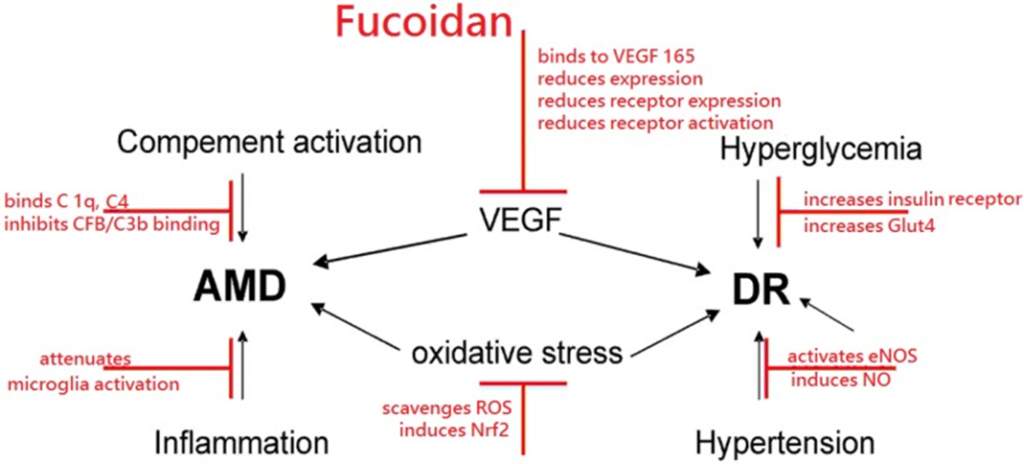Age-related macular degeneration and diabetic retinopathy are the significant cause of vision loss and blindness in developed as well as developing countries.
Diabetic retinopathy affects the nerves in the retina that sense light and color and small blood vessels that supply nutrients. If hyperglycemia continues, blood vessels in the retina are blocked, which also leads to bleeding. Sadly, if these symptoms progress, they could cause blindness.
The eye disease that age-related macular degeneration is the deterioration of the macula, the central part of the retina, causing swelling and bleeding due to a lack of oxygen and nutrients. This causes a significant portion of the visual field to be distorted, leading to failing eyesight.
On a positive note, for many reasons, Fucoidan, a natural high molecular weight polysaccharide with a sulfate group obtained from brown algae, is considered a beneficial natural supplement. It contains various useful physiological activities. Hence, Fucoidan is an exciting candidate for its therapeutic application in multiple diseases.
It is fascinating to notice that some of the features found in certain fucoidans are for potential uses of Fucoidan in age-related macular degeneration or diabetic retinopathy, such as antioxidant activity, complement inhibition, or interaction with vascular endothelial growth factor.
However, the potential use of Fucoidan in ophthalmic diseases has received little attention so far. Hence, in this blog, I want to share the study “Fucoidan as a Potential Therapeutic for Major Blinding Diseases—A Hypothesis” by Alexa Klettner. This review describes the biological activity of Fucoidan that may be interesting. As Fucoidan has many characteristics and is a stimulating substance for the treatment of significant blindness-related diseases such as diabetic retinopathy (DR) and age-related macular degeneration (AMD). Fucoidan protects against oxidative stress, reduces VEGF activity, and interferes with complement activation. It also has an immunomodulatory effect on microglia, lowers blood hypertension, reduces diabetic retinopathy in the rodent model, and improves high blood pressure.
For the development of exudative AMD, the Vascular Endothelial Growth Factor (VEGF) has been identified as the most critical factor. Furthermore, Fucoidan exhibits several anti-VEGF functions in various systems and appears to interfere with VEGF-induced signaling. Studies have proven that Fucoidan can downregulate HIF-1α / VEGF. Fucoidan is shown to reduce the expression of VEGF receptors and many more VEGF co-receptors neuropilin. In this setting, Fucoidan blocked VEGF binding to humans
It has inhibited HUVEC proliferation in response to umbilical vein endothelial cells (HUVEC) and VEGF. In addition, Undaria pinnatifida fucoidan significantly reduced the expression of VEGF in HUVEC and suppressed its angiogenic activity.
Fucoidan from several different sources is shown to lower blood glucose levels in various models of diabetes. In addition, diabetic mice lost weight, decreased blood glucose levels, and increased insulin sensitivity. In diabetic rats in which diabetes was induced by alloxan, Fucoidan from Saccarina japonica lowered blood glucose levels. It indicates that Fucoidan can help regulate blood glucose levels in a non-toxic manner. Thus, it may help prevent the development of DR (Diabetic Retinopathy) in diabetic patients.
The complement system is an enzyme cascade of the innate immune system that protects organisms from harm by promoting phagocytotic uptake, activating immune cells, and lysis (disintegrating) harmful cells and microorganisms while providing innate immunity and adaptive defense.
The complement system is predominantly activated via a classical pathway induced by binding factor C1q to a microorganism or antibody/antigen complex or by spontaneous activation of factor C3 fucoidan. Classic, and to a lesser extent, of the alternative pathway, where the alternative path is described as inhibiting activation. Here, Fucoidan is also shown to bind to C1q and C4 and inhibit the first steps of classical pathway activation. A partial effect on C3 activation was observed, and C3 convertase was also suppressed. Notably, this can be particularly interesting because the binding of CFB to C3b can be inhibited by Fucoidan, and polymorphisms in the CFB gene can increase the risk of AMD.
Figure -1 outlines the potential beneficial effects of Fucoidan. However, most features described depend highly on the source, molecular weight, sulfate, and even concentration.
Finally, these Fucoidans must be tested in a suitable animal model. For example, streptozotocin-induced diabetes in mice for diabetic retinopathy and Nrf2 knock-out mice in age-related macular degeneration. These data can then pave the way for clinical phase-one studies.

